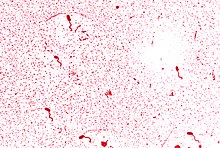
Back بكتيريا الضمة Arabic بكتيريا الضمه ARZ Вібрыёны Byelorussian Vibrió Catalan Vibrio Czech Vibrionen German Vibrio Spanish Vibrio Estonian Vibrio Basque ویبریو Persian
Vibrio is a genus of Gram-negative bacteria, possessing a curved-rod (comma) shape,[1][2][3][4] several species of which can cause foodborne infection, usually associated with eating undercooked seafood. Being highly salt tolerant and unable to survive in fresh water, Vibrio spp. are commonly found in various salt water environments. Vibrio spp. are facultative anaerobes that test positive for oxidase and do not form spores.[4][5] All members of the genus are motile. They are able to have polar or lateral flagellum with or without sheaths.[4][6] Vibrio species typically possess two chromosomes, which is unusual for bacteria.[7][8] Each chromosome has a distinct and independent origin of replication,[9] and are conserved together over time in the genus.[10] Recent phylogenies have been constructed based on a suite of genes (multilocus sequence analysis).[1]
O. F. Müller (1773, 1786) described eight species of the genus Vibrio (included in Infusoria), three of which were spirilliforms.[11] Some of the other species are today assigned to eukaryote taxa, e.g., to the euglenoid Peranema or to the diatom Bacillaria. However, Vibrio Müller, 1773 became regarded as the name of a zoological genus, and the name of the bacterial genus became Vibrio Pacini, 1854.[12][13] Filippo Pacini isolated micro-organisms he called "vibrions" from cholera patients in 1854, because of their motility.[14] In Latin "vibrio" means "to quiver".[15]
- ^ a b Cite error: The named reference
Thompson2was invoked but never defined (see the help page). - ^ Cite error: The named reference
Sherriswas invoked but never defined (see the help page). - ^ Cite error: The named reference
FaruqueNairwas invoked but never defined (see the help page). - ^ a b c Paul, Sulav Indra; Rahman, Md. Mahbubur; Salam, Mohammad Abdus; et al. (2021-12-15). "Identification of marine sponge-associated bacteria of the Saint Martin's island of the Bay of Bengal emphasizing on the prevention of motile Aeromonas septicemia in Labeo rohita". Aquaculture. 545: 737156. doi:10.1016/j.aquaculture.2021.737156. ISSN 0044-8486.
- ^ Cite error: The named reference
Brockwas invoked but never defined (see the help page). - ^ Khan, Fazlurrahman; Tabassum, Nazia; Anand, Raksha; Kim, Young-Mog (2020-10-01). "Motility of Vibrio spp.: regulation and controlling strategies". Applied Microbiology and Biotechnology. 104 (19): 8187–8208. doi:10.1007/s00253-020-10794-7. ISSN 1432-0614. PMID 32816086. S2CID 221182959.
- ^ Trucksis, Michele; Michalski, Jane; Deng, Ying Kang; Kaper, James B. (1998-11-24). "The Vibrio cholerae genome contains two unique circular chromosomes". Proceedings of the National Academy of Sciences. 95 (24): 14464–14469. Bibcode:1998PNAS...9514464T. doi:10.1073/pnas.95.24.14464. ISSN 0027-8424. PMC 24396. PMID 9826723.
- ^ Okada, Kazuhisa; Iida, Tetsuya; Kita-Tsukamoto, Kumiko; Honda, Takeshi (2005-01-15). "Vibrios Commonly Possess Two Chromosomes". Journal of Bacteriology. 187 (2): 752–757. doi:10.1128/JB.187.2.752-757.2005. ISSN 0021-9193. PMC 543535. PMID 15629946.
- ^ Rasmussen, Tue; Jensen, Rasmus Bugge; Skovgaard, Ole (2007-07-11). "The two chromosomes of Vibrio cholerae are initiated at different time points in the cell cycle". The EMBO Journal. 26 (13): 3124–3131. doi:10.1038/sj.emboj.7601747. ISSN 0261-4189. PMC 1914095. PMID 17557077.
- ^ Kirkup, Benjamin C.; Chang, LeeAnn; Chang, Sarah; et al. (2010-01-01). "Vibrio chromosomes share common history". BMC Microbiology. 10: 137. doi:10.1186/1471-2180-10-137. ISSN 1471-2180. PMC 2875227. PMID 20459749.
- ^ Pot, B., Gillis, M., and De Ley, J., The genus Aquaspirillum. In: Balows, A., Trüper, H.G., Dworkin, M., et al. (Eds.). The prokaryotes, 2nd ed, vol. 3. Springer-Verlag. New York. 1991
- ^ Hugh, R. (1964). The proposed conservation of the generic name Vibrio Pacini 1854 and designation of the neotype strain of Vibrio cholerae Pacini 1854
- ^ Hugh, R. (1964). "The Proposed Conservation of the Generic Name Vibrio Pacini 1854 and Designation of the Neotype Strain of Vibrio Cholerae Pacini 1854". International Journal of Systematic and Evolutionary Microbiology. 14 (2): 87–101. doi:10.1099/0096266X-14-2-87. S2CID 84020788.
- ^ Cite error: The named reference
AUTOREFwas invoked but never defined (see the help page). - ^ Stöppler, MD, Melissa. "Medical Definition of Vibrio cholerae". MedTerms Dictionary. MedicineNet. Retrieved 2021-06-03.
© MMXXIII Rich X Search. We shall prevail. All rights reserved. Rich X Search
